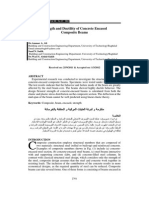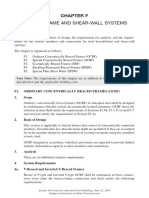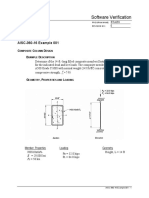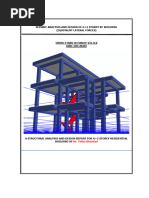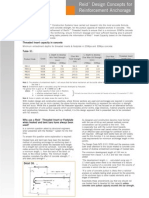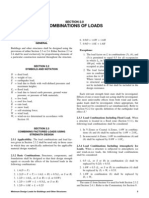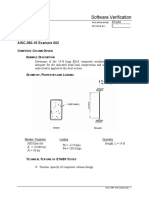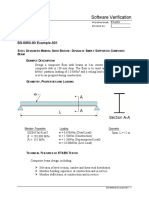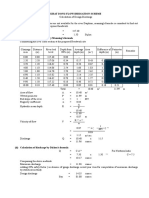AISC DG31 Example 004
Uploaded by
alejandro mantillaAISC DG31 Example 004
Uploaded by
alejandro mantillaSoftware Verification
PROGRAM NAME: ETABS
REVISION NO.: 0
AISC DG31 Example 004
COMPOSITE CELLULAR BEAM DESIGN
EXAMPLE DESCRIPTION
A 50 ft-long floor beam with simple supports, as shown below, will be evaluated as
a composite cellular section subject to uniform loading. The section is an
asymmetric section, consisting of a cut W21x44 for the top half, and of a cut
W21x57 for the bottom half. Assume that connections exist on either end to provide
stability during construction (prior to the deck being attached) and that the
connections are sufficiently rigid to prevent web post buckling at the first web post
on each end. Also, assume that the beam has been checked in its pre-composite
stage for the wet concrete weight and construction loads.
MEMBER PROPERTIES, GEOMETRY, DECK, AND LOADING
Member Properties Geometry Deck: Loading
W21x44+W21x57 Span, L = 50 ft hr = 2 in. wd = 650.6 plf (Dead Load)
→LB21x44/57 Spacing, 8 ft. o.c. tc = 3 in. wl = 800 plf (Live Load)
E = 29000 ksi Bracing, Lb = 0 in w = 145 pcf
Fy = 50 ksi f c' = 3 ksi
D0 = 20.8 in.
e = 8.0 in.
AISC DG31 Example 004 - 1
Software Verification
PROGRAM NAME: ETABS
REVISION NO.: 0
TECHNICAL FEATURES OF ETABS TESTED
Composite cellular beam design.
RESULTS COMPARISON
Independent results in this table are taken from the hand calculations presented
below. These calculations parallel, and at times adjust, the calculations presented in
Example 4.4 from “Design Guide 31: Castellated and Cellular Beam Design”,
Design Guide Series Number 31, AISC 2016.
Percent
Output Parameter ETABS Independent
Difference
Axial Force in Top Tee at 1st 0.0 0.0 0.00%
Opening, Pu (kip)
Vierendeel Moment in Top Tee at 91.0 91.0 0.00%
1st Opening, Mvu (kip-in.)
Bending Strength of Top Tee, φΜn 146.0 146.0 0.00%
(kip-in)
Bending Demand/Capacity Ratio for 0.624 0.624 0.00%
Top Tee at 1st Opening
Axial Force in Bottom Tee at 6th 180.65 180.65 0.00%
Opening, Pu (kip)
Vierendeel Moment in Bottom Tee 48.3 48.3 0.00%
at 6th Opening, Mvu (kip-in.)
Tensile Strength of Bottom Tee, 290.5 290.5 0.00%
φPn (kip)
Bending Strength of Bottom Tee, 179.7 179.7 0.00%
φΜn (kip-in)
Interaction Equation for Bottom Tee 0.861 0.861 0.00%
at 6th Opening
AISC DG31 Example 004 - 2
Software Verification
PROGRAM NAME: ETABS
REVISION NO.: 0
Horizontal Shear at 1st Web Post, 38.9 38.9 0.00%
Vuh, (kip)
Horizontal Shear Capacity of Web 84.0 84.0 0.00%
Posts, φVn-horiz (kip)
Local Bending Moment at 1st Web 364.3 364.3 0.00%
Post, Muh (kip-in)
Bending Strength of Web Posts, 445.9 445.9 0.00%
ΦΜallow(kip-in)
Vertical Shear at 1st Opening Top 20.5 20.5 0.00%
Tee, Vu-tee-top (kip)
Vertical Shear at 1st Opening 27.8 27.8 0.00%
Bottom Tee, Vu-tee-bot (kip)
Top Tee Shear Capacity, φVn-tee-top 49.9 49.9 0.00%
(kip)
Bottom Tee Shear Capacity, 60.1 60.1 0.00%
φVn—tee-bot (kip)
Vertical Shear at Beam Ends, 51.5 51.5 0.00%
Vu (kip)
Gross Section Shear Capacity, 212.4 212.4 0.00%
φVn-gross (kip)
Dead Load Deflection (in.) 1.7 1.7 0.00%
Live Load Deflection (in.) 0.8 0.8 0.00%
COMPUTER FILE: AISC DG31 EXAMPLE 004.EDB
CONCLUSION
The ETABS results show an excellent comparison with the independent results.
AISC DG31 Example 004 - 3
Software Verification
PROGRAM NAME: ETABS
REVISION NO.: 0
HAND CALCULATION
Section Properties:
Top Root Section:
W21x44:
A = 13.0 in2, d =20.7 in, tw = 0.35 in, bf = 6.5 in, tf = 0.45 in
Sx = 81.6 in3, Z = 81.6 in3, Ix = 843 in4
Bottom Root Section
W21x57:
A = 16.7 in2, d =21.1 in, tw = 0.405 in, bf = 6.56 in, tf = 0.65 in
Sx = 111 in3, Z = 129 in3, Ix = 1170 in4
Hole Dimensions:
D0 = 20.8in.
e = 8.0 in.
S =e + D0 =8.0 + 20.8 =28.8in.
2 2 2 2
D0 D S − D0 20.8 20.8 28.8 − 20.8
loss = − 0 − =− − 0.80in.
=
2 2 2 2 2 2
1 D 1 20.8
dt −top − net= d top − 0 + loss = 20.7 − + 0.8 = 4.75in.
2 2 2 2
1 D 1 20.8
dt −bot − net= d bot − 0 + loss = 21.1 − + 0.8 = 4.95in.
2 2 2 2
d g = dt −top − net + D0 + dt −bot − net = 4.75 + 20.8 + 4.95 = 30.5in.
y = (0.5 D0 ) 2 − (0.225 D0 ) 2 = (0.5 • 20.8) 2 − (0.225 • 20.8) 2 =9.29in.
D0 20.8
dt −top −crit = − y + dt −top − net = − 9.29 + 4.75= 5.86in.
2 2
D0 20.8
dt −bot −crit = − y + dt −bot − net = − 9.29 + 4.95= 6.06in.
2 2
AISC DG31 Example 004 - 4
Software Verification
PROGRAM NAME: ETABS
REVISION NO.: 0
Properties of Top Tees at Opening Centers:
Moment of inertia about x-axis – with the fillet radius taken as zero:
Area Distance to Ay Ay2 I0
A (in2) Flange Mid (in.3) (in.4) (in.4)
Depth y (in.)
Flange 2.925 0 0 0 0.05
Stem 1.505 2.38 3.574 8.49 2.32
Tee 4.43 3.574 8.49 2.37
y0−t −=
∑=
Ay 3.574
= 0.807 in.
top − net
At −top − net 4.43
I x −t −top − net = ∑ I + ∑ Ay
0
2
− At −top − net y02−t −top − net = 2.37 + 8.49 − 4.43 • 0.812 = 7.97 in.4
Properties of Top Tees at Critical Sections:
Moment of inertia about x-axis – with the fillet radius taken as zero:
Area Distance to Ay Ay2 I0
A (in2) Flange Mid (in.3) (in.4) (in.4)
Depth y (in.)
Flange 2.925 0 0 0 0.05
Stem 1.894 2.93 5.553 16.28 4.62
Tee 4.819 5.553 16.28 4.67
y0−t −=
∑=
Ay 5.553
= 1.152 in.
top − crit
At −top −crit 4.819
I x −t −top −crit = ∑ I 0 + ∑ Ay 2 − At −top −crit y02−t −top −crit = 4.67 + 16.28 − 4.82 • 1.152 = 14.55 in.4
I x −t −top −crit 14.55
S x − min −t −top −crit
= = = 3.24in 3
dt −top −crit − ( y0−t −top −crit + 0.5t f −top ) 5.86 − (1.152 + 0.5 • 0.45 )
AISC DG31 Example 004 - 5
Software Verification
PROGRAM NAME: ETABS
REVISION NO.: 0
Properties of Bottom Tees at Opening Centers:
Moment of inertia about x-axis – with the fillet radius taken as zero:
Area Distance to Ay Ay2 I0
A (in2) Flange Mid (in.3) (in.4) (in.4)
Depth y (in.)
Flange 4.264 0 0 0 0.15
Stem 1.7415 2.48 4.31 10.67 2.68
Tee 6.0055 4.31 10.67 2.83
y0−t=
∑
=
Ay 4.31
= 0.718 in.
−bot − net
At −bot − net 6.0055
I x −t −bot − net =∑ I 0 + ∑ Ay 2 − At −bot − net y02−t −bot − net =2.83 + 10.67 − 6.0055 • 0.722 =10.4 in.4
Properties of Bottom Tees at Critical Sections:
Moment of inertia about x-axis – with the fillet radius taken as zero:
Area Distance to Ay Ay2 I0
A (in2) Flange Mid (in.3) (in.4) (in.4)
Depth y (in.)
Flange 4.264 0 0 0 0.15
Stem 2.192 3.03 6.645 20.14 5.35
Tee 6.456 6.645 20.14 5.5
y0−t −bot
=
∑=
Ay 6.645
= 1.029 in.
− crit
At −bot −crit 6.456
I x −t −bot −crit =∑ I 0 + ∑ Ay 2 − At −bot −crit y02−t −bot −crit =5.5 + 20.14 − 6.45 • 1.032 =18.8 in.4
I x −t −bot −crit 18.8
S x − min −t −bot −crit
= = = 3.99in 3
dt −bot −crit − ( y0−bot −crit + 0.5t f −bot ) 6.06 − (1.029 + 0.5 • 0.65 )
AISC DG31 Example 004 - 6
Software Verification
PROGRAM NAME: ETABS
REVISION NO.: 0
Properties of Net Section at Opening Centers:
Moment of inertia about x-axis – with the fillet radius taken as zero:
Area Distance to Ay Ay2 I0
A (in2) Bottom y (in.3) (in.4) (in.4)
(in.)
Top Tee 4.430 29.47 130.544 3486.89 7.97
Bottom Tee 6.0055 1.04 6.262 6.53 10.41
Net Section 10.4355 136.81 3853.42 18.38
ysteel
=
∑
=
Ay 136.81
= 13.1097 in.
− net
Anet 10.436
I steel − net =∑ I 0 + ∑ Ay 2 − Anet ynet2 =18.38 + 3853.42 − 10.4355 •13.10972 =2078.3 in.4
Properties of Net Section at Critical Sections:
Anet −crit = At −top −crit + At −bot −crit = 4.82 + 6.46 = 11.28in 2
d g − ( 0.5t f −top + y0−t −top −crit ) − ( 0.5t f −bot + y0−t −bot −crit )
d effec − noncomp =
= 30.5 − ( 0.5 • 0.45 + 1.152 ) − ( 0.5 • 0.65 + 1.029 ) = 27.77 in.
Properties of Net Composite Section at Opening Centers
Moment of inertia about x-axis – with the fillet radius taken as zero:
Area Distance to Ay Ay2 I0
A (in2) Bottom y (in.) (in.3) (in.4) (in.4)
Transformed 31.3416 34 1065.61 36230.9 23.5
Slab
Net Section 10.4355 13.11 136.81 1793.5 2078.3
Composite 41.777 1202.42 38024.4 2101.8
Section
AISC DG31 Example 004 - 7
Software Verification
PROGRAM NAME: ETABS
REVISION NO.: 0
ytr − net
=
∑
=
Ay 1202.42
= 28.782 in.
Atr − net 41.777
I comp − net =∑ I 0 + ∑ Ay 2 − Atr − net ytr2 − net =2101.8 + 38024.4 − 41.777 • 28.7822 =5518.4 in.4
Global and Local Forces in Top Tee at 1st Opening:
Loading:
wu = 1.2 wd + 1.6 wl = 1.2 • 0.6506 + 1.6 • 0.8 = 2.0607 kip/ft
Location:
x =e + 0.5 D0 =8 + 0.5 • 20.8 =18.4in.
Global Shear:
L 50 18.4
V=
u 2.0607 • ( −
wu − x= =) 48.36 kips
2 2 12
( )
Vnc = 3 ( hr + tc )( tc ) 4 f c' = 3 • ( 2 + 3) • 3 • 4 3000 = 9,859 psi = 9.9 ksi
Vc = φcvVnc = 0.75 • 9.9 = 7.4 ksi
Vnet = Vu − Vc = 48.36 − 7.4 = 40.96 kips
Global Bending Moment:
wu x 2.0607 • 18.4 18.4
M
= u ( L −=
x) 50 − = 76.6 kip-ft
2 2 • 12 12
Axial Force in Top Tee:
Assuming full composite action and with a depth of concrete in compression, Xc,
equal to:
X c = 0.11in.
the composite effective depth of the beam, deffec-comp, is equal to:
AISC DG31 Example 004 - 8
Software Verification
PROGRAM NAME: ETABS
REVISION NO.: 0
Xc
d effec −comp = d g − ( 0.5t f −bot + y0−t −bot −crit ) + hr + tc −
2
0.11
= 30.5 − ( 0.5 • 0.65 + 1.029 ) + 2 + 3 − = 34.09in.
2
and the compression force in the concrete, C1, which is equal to:
C=
1 0.85 f c' X c beff= 0.85 • 3 • 0.11 • 96
= 26.95 kips
satisfies:
Mu 76.6 • 12
=C1 = = 26.95 kips
d effec −comp 34.09
C1 26.95 kips < qX
Because = =i
∑Q =
50 • 21
X n
(18.4 − 0.5
= ) 31.4 kips , the
i
Span 50 • 12 − 1
assumption of full composite action is valid and the axial force in the top tee is zero.
Vierendeel Moment in Top Tee:
At −top −crit D0 40.96 • 4.82 • 20.8
=M vu −top V=
net = 91.0 kip-in
Anet −crit 4 11.28 • 4
Bending Strength of Top Tee at Critical Sections:
Yielding:
M p =M y =Fy S x − min −t −top −crit =50 • 3.24 =162.2 kip-in
Local Buckling of Tee Stem:
E
Because d / tw < 0.84 , Fcr = Fy and
Fy
M n =Fcr S x − min −t −bot −crit =50 • 3.24 =162.2 kip-in
Bending Demand/Capacity Ratio for Top Tee at Critical Section at 1st Opening:
M vu 91.0
= = 0.624
φ M n 0.9 • 162.2
AISC DG31 Example 004 - 9
Software Verification
PROGRAM NAME: ETABS
REVISION NO.: 0
Global and Local Forces in Bottom Tee at 6th Opening:
Location:
x = e + 6 S + 0.5 D0 = 8 + 5 • 28.8 + 0.5 • 20.8 = 162.4in.
Global Shear:
L 50 162.4
V=
u 2.0607 • ( −
wu − x= =) 23.63kips
2 2 12
Vnet = Vu − Vc = 23.63 − 7.4 = 16.23kips
Global Bending Moment:
wu x 2.0607 • 162.4 162.4
M
= u ( L −=
x) 50 − = 508.49 kip-ft
2 2 • 12 12
Axial Force in Bottom Tee:
Assuming full composite action and with a depth of concrete in compression, Xc,
equal to:
X c = 0.73796in.
the composite effective depth of the beam, deffec-comp, is equal to:
Xc
d effec −comp = d g − ( 0.5t f −bot + y0−t −bot −crit ) + hr + tc −
2
0.73796
= 30.5 − ( 0.5 • 0.65 + 1.029 ) + 2 + 3 − = 33.777 in.
2
and the compression force in the concrete, C1, which is equal to:
C=
1 0.85 f c' X c beff= 0.85 • 3 • 0.73796 • 96
= 180.65 kips
satisfies:
Mu 508.49 • 12
=C1 = = 180.65 kips
d effec −comp 33.777
C1 180.65 kips < qX
Because= =
∑Q =
50 • 21
X n
(162.4 − 0.5
= ) 283.8 kips , the
i i
Span 50 • 12 − 1
assumption of full composite action is valid, and the tension force in the bottom tee,
Pu, is equal to C1.
AISC DG31 Example 004 - 10
Software Verification
PROGRAM NAME: ETABS
REVISION NO.: 0
Vierendeel Moment in Bottom Tee:
At −bot −crit D0 16.23 • 6.46 • 20.8
=M vu V=
net = 48.34 kip-in
Acrit 4 11.28 • 4
Tensile Strength of Bottom Tee at Critical Sections:
Pn =Fy At −bot −crit =50 • 6.46 =322.8 kips
Bending Strength of Bottom Tee at Critical Sections:
Yielding:
M p =M y =Fy S x −bot =50 • 3.99 =199.7 kip-in
Local Buckling of Tee Stem:
E
Because d / tw < 0.84 , Fcr = Fy and
Fy
M n =Fcr S x −bot =50 • 3.99 =199.7 kip-in
Interaction Equation for Bottom Tee at Critical Section at 6th Opening:
Equation H1-1a:
Pu 8 M vu 180.65 8 48.34
+ = + = 0.861 controls
φ Pn 9 φ M n 0.9 • 322.8 9 0.9 • 199.7
Equation H1-1b:
Pu M vu 180.65 48.34
+
= + = 0.580
2φ Pn φ M n 2 • 0.9 • 322.8 0.9 • 199.7
Bending Moment at 1st Web Post:
Axial Force in Bottom Tee at 1st Opening:
As seen above, the axial force in the bottom tee at the previous opening, Tu1, is
equal to:
Tu1 = 26.95 kips
AISC DG31 Example 004 - 11
Software Verification
PROGRAM NAME: ETABS
REVISION NO.: 0
Global Bending Moment at 2nd Opening:
x2 = e + S + 0.5 D0 = 8 + 28.8 + 0.5 • 20.8 = 47.2in.
wu x2 2.0607 • 47.2 47.2
M=
u2 ( L − x=
2) 50 − = 186.69 kip-ft
2 2 • 12 12
Axial Force in Bottom Tee at 2nd Opening:
Assuming full composite action and with a depth of concrete in compression, Xc,
equal to:
X c = 0.26908in.
the composite effective depth of the beam, deffec-comp, is equal to:
Xc
d effec −comp = d g − ( 0.5t f −bot + y0−bot ) + hr + tc −
2
0.26908
= 30.5 − ( 0.5 • 0.65 + 1.029 ) + 2 + 3 − = 34.011in.
2
and the compression force in the concrete, C1, which is equal to:
C=
1 0.85 f c' X c beff= 0.85 • 3 • 0.26908 • 96
= 65.87 kips
satisfies:
Mu2 186.69 • 12
=C2 = = 65.87 kips
d effec −comp 34.011
C1 65.87kips < qX
Because = =
∑Q =
50 • 21
X n
= 81.9 kips , the
• (47.2 − 0.5)
i i
Span 50 • 12 − 1
assumption of full composite action is valid, meaning the axial force in the bottom
tee, Tu2, is equal to C1.
Horizontal Shear Force in Web Post:
Vuh = Tu 2 − Tu1 = 65.87 − 26.95 = 38.92 kips
Bending Moment in Web Post:
D0 20.8
M uh =0.9 Vuh =0.9 • • 38.92 =364.3kip-in.
2 2
AISC DG31 Example 004 - 12
Software Verification
PROGRAM NAME: ETABS
REVISION NO.: 0
Web Post Horizontal Shear Strength:
φVn − horiz= φv 0.6 Fy etw−top= 0.6 • 50 • 8 • 0.35= 84.0 kips
Web Post Flexural Strength:
Elastic Bending Moment:
tw ( S − D0 + 0.564 D0 ) 2 0.2(28.8 − 20.8 + 0.564 • 20.8) 2
=Me = Fy = 50 1135.5 kip-in.
6 6
Buckling Moment:
2
D D
C1 =
5.097 + 0.1464 0 − 0.00174 0
tw tw
2
20.8 20.8
= 5.097 + 0.1464 − 0.00174
0.35 0.35
= 7.65
2
D D
C2 =
1.441 + 0.0625 0 − 0.000683 0
tw tw
2
20.8 20.8
= 1.441 + 0.0625 − 0.000683
0.35 0.35
= 2.74
2
D D
C3 =
3.645 + 0.0853 0 − 0.00108 0
tw tw
2
20.8 20.8
= 3.645 + 0.0853 − 0.00108
0.35 0.35
= 4.90
AISC DG31 Example 004 - 13
Software Verification
PROGRAM NAME: ETABS
REVISION NO.: 0
S S
2
φb M allow= 0.9 C1 − C 2 − C 3 M e
D0 D0
28.8 28.8
2
= 0.9 7.65 − 2.74 − 4.90 • 1135.5
20.8 20.8
= 445.9 kip-in.
Vertical Shear in Tees at 1st Opening:
Location:
x =e + 0.5 D0 =8 + 0.5 • 20.8 =18.4in.
Shear:
L 50 18.4
V=
u 2.0607 • ( −
wu − x= =) 48.36 kips
2 2 12
At −top − net 4.43
Vu −top −tee= Vu= • 48.36= 20.53kips
Anet 10.4355
At −bottom − net 6.0055
Vu −bottom −tee= Vu= • 48.36= 27.83kips
Anet 10.4355
Shear Strength:
h dt −top − net 4.75
Because = == 13.6 ≤ 1.1 kv E / Fy = 29 ,
1.1 1.2 • 29000 / 50 =
tw tw−top 0.35
Cv 2 = 1.0 and:
φvVn −tee −top = φv 0.6 Fy (dt −top − net tw−top )Cv 2 = 1.0 • 0.6 • 50 • (4.75 • 0.35) • 1.0 = 49.9 kips
h dtee 4.95
Because = == 12.2 ≤ 1.1 kv E / Fy = 29 , Cv 2 = 1.0
1.1 1.2 • 29000 / 50 =
tw tw 0.405
and:
φvVn −tee −bot = φv 0.6 Fy (dt −bot − net tw−bot )Cv 2 = 1.0 • 0.6 • 50 • (4.95 • 0.405) • 1.0 = 60.1kips
AISC DG31 Example 004 - 14
Software Verification
PROGRAM NAME: ETABS
REVISION NO.: 0
Vertical Shear at Gross Section:
Shear:
L 50
Vu = wu = 2.06 • = 51.5 kips
2 2
Shear Strength:
The root W21x44 and W21x55 sections have been defined without fillets in the
ETABS model in order to obtain the same tee properties in ETABS and in these
calculations. This will lead to in a different value of the gross section shear strength
because ETABS automatically assumes a fillet equal to one-tenth the flange
thickness when computing the shear strength of an I-section without fillets.
Making the same fillet assumption as ETABS for the gross section:
h 30.5 − 2 • 1.1 • 0.65
= = 83.06
tw 0.35
h
and because ≥ 1.1 kv E / Fy =1.1 5.34 • 29000 / Fy =61.2 :
tw
1.1 kv E / Fy 1.1 5.34 • 29000 / 50
=Cv1 = = 0.737
h / tw 83.06
and:
φvVn − gross = φv 0.6 Fy (d g tw )Cv1 = 0.9 • 0.6 • 50 • 30.5 • 0.35 • 0.737 = 212.4 kips
Dead Load Deflection:
5 L4 (0.651/12) • 5 • (50 • 12) 4
=δ dead w=
dead = 1.7 in.
384 E (0.9 I steel − net ) 384 • 29, 000 • 0.9 • 2, 078
Live Load Deflection:
5 L4 (0.8 /12) • 5 • (50 • 12) 4
=δ live w=
live = 0.8in.
384 E (0.9 I comp − net ) 384 • 29, 000 • 0.9 • 5,518
AISC DG31 Example 004 - 15
You might also like
- STA Captain - S Log Solo RPG (TNG Cover) v1.41100% (21)STA Captain - S Log Solo RPG (TNG Cover) v1.41336 pages
- Dodge Ram 1500 2009 Workshop Service Repair Manual PDF Download0% (5)Dodge Ram 1500 2009 Workshop Service Repair Manual PDF Download2 pages
- Harbor Freight Cen-Tech CAN OBD II Code Reader EOBD Scanner 9861475% (8)Harbor Freight Cen-Tech CAN OBD II Code Reader EOBD Scanner 9861473 pages
- OceanofPDF - Com How To Draw Cool Stuff Shading Textures - Catherine V Holmes100% (5)OceanofPDF - Com How To Draw Cool Stuff Shading Textures - Catherine V Holmes294 pages
- Ase Study Guide - Parts Specialist (P2)No ratings yetAse Study Guide - Parts Specialist (P2)23 pages
- Manual Hyster 4000701-8000SRM1409 - (04-2012) - Us-En100% (5)Manual Hyster 4000701-8000SRM1409 - (04-2012) - Us-En84 pages
- Quality Control and Continuous ImprovementNo ratings yetQuality Control and Continuous Improvement14 pages
- QES PEVC-ENG262 - Checklist For Tower Foundation Design & DrawingNo ratings yetQES PEVC-ENG262 - Checklist For Tower Foundation Design & Drawing2 pages
- Article: Connecting Hollow Structural Section Members With Through-BoltsNo ratings yetArticle: Connecting Hollow Structural Section Members With Through-Bolts4 pages
- CRSI Manual To Design RC Diaphragms - Part33No ratings yetCRSI Manual To Design RC Diaphragms - Part334 pages
- Design and Performance of Screw Piles: Final Project ReportNo ratings yetDesign and Performance of Screw Piles: Final Project Report19 pages
- Sample Ribbed Slab Design by TCC SpreadsheetsNo ratings yetSample Ribbed Slab Design by TCC Spreadsheets3 pages
- Combined Footing Design: ASDIP Foundation 2.6.1No ratings yetCombined Footing Design: ASDIP Foundation 2.6.13 pages
- Software Verification: AISC-360-16 Example 001No ratings yetSoftware Verification: AISC-360-16 Example 0014 pages
- Modelling Soil Stiffness As Spring Support: Thread507-263600No ratings yetModelling Soil Stiffness As Spring Support: Thread507-2636003 pages
- Tirtha Bhandari (STR Report) - Sep 01 2023No ratings yetTirtha Bhandari (STR Report) - Sep 01 202356 pages
- Stability Analysis - Direct Analysis Method - Staad Pro AISC 360No ratings yetStability Analysis - Direct Analysis Method - Staad Pro AISC 3604 pages
- Ove Arup & Partners Hong Kong LTD.: Tensile Reinfrocement Compression ReinforcementNo ratings yetOve Arup & Partners Hong Kong LTD.: Tensile Reinfrocement Compression Reinforcement16 pages
- Buckling Analysis: I. Definition and PurposeNo ratings yetBuckling Analysis: I. Definition and Purpose4 pages
- Design and Behavior of Gusset Plate Connections PDFNo ratings yetDesign and Behavior of Gusset Plate Connections PDF12 pages
- A Good Quality Task 1 Report-For Guidance Only0% (1)A Good Quality Task 1 Report-For Guidance Only39 pages
- Partially Grouted Walls: B Effective Compressive Width Per Bar Min (S, 6t, 72 In) (5.1.2)No ratings yetPartially Grouted Walls: B Effective Compressive Width Per Bar Min (S, 6t, 72 In) (5.1.2)18 pages
- Notaton X Foreword X 1 Introducton 1: Istructe Manual For The Design of Concrete Building Structures To Eurocode 2No ratings yetNotaton X Foreword X 1 Introducton 1: Istructe Manual For The Design of Concrete Building Structures To Eurocode 27 pages
- Worked Example - Hollow Section (CHS Only)No ratings yetWorked Example - Hollow Section (CHS Only)6 pages
- Lateral Buckling Resistance of Inelastici-Beams Under Off-Shear Center LoadingNo ratings yetLateral Buckling Resistance of Inelastici-Beams Under Off-Shear Center Loading6 pages
- Safe Notes Foundation and Slab Design Procedurepdf PDF FreeNo ratings yetSafe Notes Foundation and Slab Design Procedurepdf PDF Free16 pages
- Load Capacities of Threaded Hanger Rods Are Indicated in The Table BelowNo ratings yetLoad Capacities of Threaded Hanger Rods Are Indicated in The Table Below1 page
- Building Structural Design Thomas P. Magner, P.E. © 2011 Parametric Technology CorpNo ratings yetBuilding Structural Design Thomas P. Magner, P.E. © 2011 Parametric Technology Corp41 pages
- WIND02 v2-21: Detailed Wind Load Analysis Per ASCE 7-10100% (1)WIND02 v2-21: Detailed Wind Load Analysis Per ASCE 7-103 pages
- Software Verification: AISC-360-16 Example 003No ratings yetSoftware Verification: AISC-360-16 Example 0034 pages
- Software Verification: AISC-360-10 Example 002No ratings yetSoftware Verification: AISC-360-10 Example 0023 pages
- Software Verification: AISC-360-16 Example 002No ratings yetSoftware Verification: AISC-360-16 Example 0023 pages
- Software Verification: AISC-360-16 Example 006No ratings yetSoftware Verification: AISC-360-16 Example 0065 pages
- Software Verification: AISC-360-16 Example 005No ratings yetSoftware Verification: AISC-360-16 Example 0053 pages
- Software Verification: AISC-360-16 Example 004100% (2)Software Verification: AISC-360-16 Example 0044 pages
- Software Verification: AISC-360-16 Example 003No ratings yetSoftware Verification: AISC-360-16 Example 0035 pages
- Notice Date: 29-March-2021: Etabs V19.1.0 ReadmeNo ratings yetNotice Date: 29-March-2021: Etabs V19.1.0 Readme7 pages
- Notice Date: 29-March-2021: ETABS v19.1.0 Release NotesNo ratings yetNotice Date: 29-March-2021: ETABS v19.1.0 Release Notes11 pages
- Practical Projects For Self-Sufficiency - DIY Projects To Get Your Self-Reliant Lifestyle Started PDF88% (16)Practical Projects For Self-Sufficiency - DIY Projects To Get Your Self-Reliant Lifestyle Started PDF163 pages
- Owners Manual QSL9 CM2350 L102: Cummins Customer Assistance Center 1-800-DIESELS Applicable Only in U.S.A. and CanadaNo ratings yetOwners Manual QSL9 CM2350 L102: Cummins Customer Assistance Center 1-800-DIESELS Applicable Only in U.S.A. and Canada201 pages
- ASVAB Mechanical Comprehension Practice Test 3No ratings yetASVAB Mechanical Comprehension Practice Test 38 pages
- Quantum Energy Generator (QEG) - REVISED Manual Edition (March 2015)100% (5)Quantum Energy Generator (QEG) - REVISED Manual Edition (March 2015)75 pages
- HemiSync - Gateway Experience - Wave V Exploring PDF100% (10)HemiSync - Gateway Experience - Wave V Exploring PDF16 pages
- Kartbuilding Blog: Archive For The 'Chassis Design' CategoryNo ratings yetKartbuilding Blog: Archive For The 'Chassis Design' Category9 pages
- 3 Bending Stresses & Shear Stresses in Beams PDFNo ratings yet3 Bending Stresses & Shear Stresses in Beams PDF107 pages
- Operate Basic Flow Control and Regulating Devices in (Autosaved)No ratings yetOperate Basic Flow Control and Regulating Devices in (Autosaved)28 pages
- Investigation of Discharge Coefficient of Louvre Openings in - Iaqvec2023 - 02030No ratings yetInvestigation of Discharge Coefficient of Louvre Openings in - Iaqvec2023 - 020308 pages
- Impact of Weather Conditions On ConcretingNo ratings yetImpact of Weather Conditions On Concreting3 pages
- Part 3 Global Reservoir Flow Regimes AzebNo ratings yetPart 3 Global Reservoir Flow Regimes Azeb38 pages
- ICS-A02-1103 (B1) Hydraulic Calculations (090110)No ratings yetICS-A02-1103 (B1) Hydraulic Calculations (090110)12 pages
- Dodge Ram 1500 2009 Workshop Service Repair Manual PDF DownloadDodge Ram 1500 2009 Workshop Service Repair Manual PDF Download
- Harbor Freight Cen-Tech CAN OBD II Code Reader EOBD Scanner 98614Harbor Freight Cen-Tech CAN OBD II Code Reader EOBD Scanner 98614
- OceanofPDF - Com How To Draw Cool Stuff Shading Textures - Catherine V HolmesOceanofPDF - Com How To Draw Cool Stuff Shading Textures - Catherine V Holmes
- Manual Hyster 4000701-8000SRM1409 - (04-2012) - Us-EnManual Hyster 4000701-8000SRM1409 - (04-2012) - Us-En
- QES PEVC-ENG262 - Checklist For Tower Foundation Design & DrawingQES PEVC-ENG262 - Checklist For Tower Foundation Design & Drawing
- Article: Connecting Hollow Structural Section Members With Through-BoltsArticle: Connecting Hollow Structural Section Members With Through-Bolts
- Design and Performance of Screw Piles: Final Project ReportDesign and Performance of Screw Piles: Final Project Report
- Modelling Soil Stiffness As Spring Support: Thread507-263600Modelling Soil Stiffness As Spring Support: Thread507-263600
- Stability Analysis - Direct Analysis Method - Staad Pro AISC 360Stability Analysis - Direct Analysis Method - Staad Pro AISC 360
- Ove Arup & Partners Hong Kong LTD.: Tensile Reinfrocement Compression ReinforcementOve Arup & Partners Hong Kong LTD.: Tensile Reinfrocement Compression Reinforcement
- Design and Behavior of Gusset Plate Connections PDFDesign and Behavior of Gusset Plate Connections PDF
- Partially Grouted Walls: B Effective Compressive Width Per Bar Min (S, 6t, 72 In) (5.1.2)Partially Grouted Walls: B Effective Compressive Width Per Bar Min (S, 6t, 72 In) (5.1.2)
- Notaton X Foreword X 1 Introducton 1: Istructe Manual For The Design of Concrete Building Structures To Eurocode 2Notaton X Foreword X 1 Introducton 1: Istructe Manual For The Design of Concrete Building Structures To Eurocode 2
- Lateral Buckling Resistance of Inelastici-Beams Under Off-Shear Center LoadingLateral Buckling Resistance of Inelastici-Beams Under Off-Shear Center Loading
- Safe Notes Foundation and Slab Design Procedurepdf PDF FreeSafe Notes Foundation and Slab Design Procedurepdf PDF Free
- Load Capacities of Threaded Hanger Rods Are Indicated in The Table BelowLoad Capacities of Threaded Hanger Rods Are Indicated in The Table Below
- Building Structural Design Thomas P. Magner, P.E. © 2011 Parametric Technology CorpBuilding Structural Design Thomas P. Magner, P.E. © 2011 Parametric Technology Corp
- WIND02 v2-21: Detailed Wind Load Analysis Per ASCE 7-10WIND02 v2-21: Detailed Wind Load Analysis Per ASCE 7-10
- Notice Date: 29-March-2021: ETABS v19.1.0 Release NotesNotice Date: 29-March-2021: ETABS v19.1.0 Release Notes
- Practical Projects For Self-Sufficiency - DIY Projects To Get Your Self-Reliant Lifestyle Started PDFPractical Projects For Self-Sufficiency - DIY Projects To Get Your Self-Reliant Lifestyle Started PDF
- Owners Manual QSL9 CM2350 L102: Cummins Customer Assistance Center 1-800-DIESELS Applicable Only in U.S.A. and CanadaOwners Manual QSL9 CM2350 L102: Cummins Customer Assistance Center 1-800-DIESELS Applicable Only in U.S.A. and Canada
- Quantum Energy Generator (QEG) - REVISED Manual Edition (March 2015)Quantum Energy Generator (QEG) - REVISED Manual Edition (March 2015)
- HemiSync - Gateway Experience - Wave V Exploring PDFHemiSync - Gateway Experience - Wave V Exploring PDF
- Kartbuilding Blog: Archive For The 'Chassis Design' CategoryKartbuilding Blog: Archive For The 'Chassis Design' Category
- Operate Basic Flow Control and Regulating Devices in (Autosaved)Operate Basic Flow Control and Regulating Devices in (Autosaved)
- Investigation of Discharge Coefficient of Louvre Openings in - Iaqvec2023 - 02030Investigation of Discharge Coefficient of Louvre Openings in - Iaqvec2023 - 02030






























